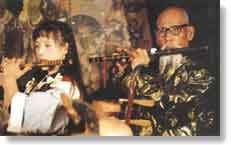 Baisha Fine Music
Baisha Fine Music
 Passed down as the "Musical Legacy of theYuan Dynasty(1271-1368),"baishafine music is one of ancient China's large-scale, classical orchestral music that contains choruses, clear storylines, and musicmovements.Baishafine music consists of dance, songs, and instrumental music that have twenty-four tunes, locally known asqupai. Although archaic, simple, and elegant in style, modern baisha is exquisite, euphonious, and dynamic in character.
Passed down as the "Musical Legacy of theYuan Dynasty(1271-1368),"baishafine music is one of ancient China's large-scale, classical orchestral music that contains choruses, clear storylines, and musicmovements.Baishafine music consists of dance, songs, and instrumental music that have twenty-four tunes, locally known asqupai. Although archaic, simple, and elegant in style, modern baisha is exquisite, euphonious, and dynamic in character.
It is said that whenKublai Khanwas on his expedition to Yunnan, he once received help from Mailiang, the leader of the Naxi people inLijiang, a city in southernYunnan Provincewhere some of the Naxi lived. On his departure, Kublai Khan left to Mailiang half a band and a musical score as a gift. Therefore,baishafine music is also called "honoraria on departure".
 Dong Jing Music
Dong Jing Music
This type of Daoist music is widely spread among the Naxi people. Since the Ming (1368-1644) and Qing (1644-1911) dynasties, it has been gradually introduced to Yunnan from Central China, and is deeply rooted in the cultural circles of the Naxi people. Over time, the Naxi have added their own styles and the skills used in playing their local folk songs when playing dong jing music, giving the music a Naxi musical tone.
Afterdong jingmusic was disseminated to Lijiang, for quite a long time, its enjoyment was confined to gentlemen, whom were the only ones allowed to participate indong jingconcerts. However, as the Naxi people are born with a musical nature, such a limiting shackle was eventually broken.
Today, folk musicians have already madedong jingmusic a part of the folk world. There are at least four full orchestras of elderly men in and around Lijiang, and within the county there are scores of folk bands playing the ancient music that has been blended with Naxi flavor.
